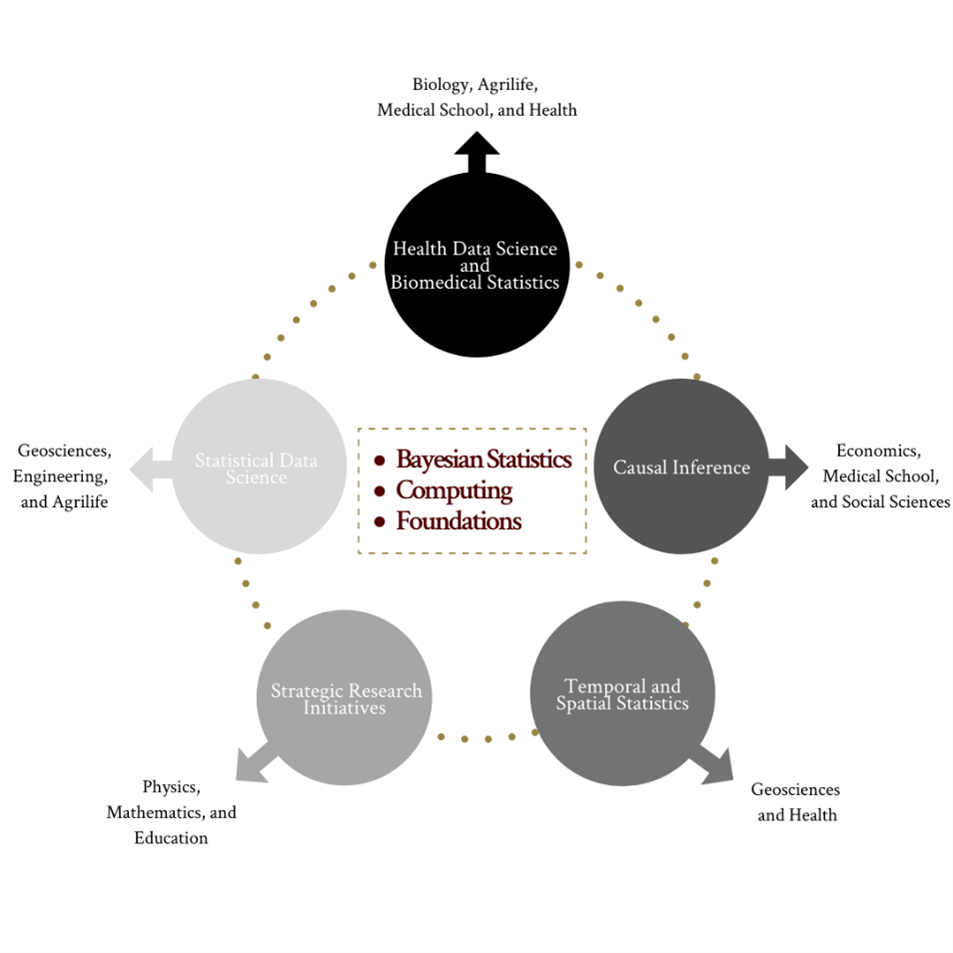Statistical science is a broad discipline that encompasses activities from data acquisition and
processing, exploratory data analysis, complex modeling of stochastic processes, inference,
hypothesis testing, parameter estimation, uncertainty quantification, Bayesian and casual inference, and decision making under uncertainty. The Department’s mission is to function as a leading international center for statistical research, education, and service.
The Department boasts a diverse array of research in statistical methodology and applications, with faculty members recognized nationally and internationally for their contributions to the field. Among the accolades received are the COPPS Award (Carroll), the Noether Senior Scholar Award and Lecture (Carroll, Spiegelman), and the Wilcoxon Prize (Carroll). These awards underscore the Department's commitment to advancing statistical science and its impact on the broader academic community.
Current strengths of Department include spatial statistics, Bayesian methodology, functional data analysis, modeling of measurement error, non-parametric methods, analysis of high and ultrahigh dimensional data, causal inference, and computational bioinformatics. Further discussion of the faculty’s research productivity is provided throughout our webpages.
As part of a land-grant university, the Department takes its responsibility for statistical education very seriously. The Department teaches approximately 5,700 undergraduate students each year. A vast majority of these students enroll in service courses designed to provide a rudimentary understanding of statistics that will allow them to interpret scientific findings in their fields of study, as well as to interpret statistical analysis reported in popular media, government studies and business reports. The more advanced of these courses also provide students with background in experimental design, the statistical analysis of simple experiments and observational studies, and regression analysis.
Our excellent academic environment fosters world-class, modern, and impactful research.
The Statistics Department will advance five research goals that were initially identified during the SOAR meeting and refined by working group suggestions and Statistics faculty feedback. These research goals significantly enhance the existing strengths and unique capabilities of the Statistics Department and look to the future of statistical research by identifying innovative strategic initiatives that require new statistical foundations, methodology, computational thinking, and infrastructure. Our five identified research goals are facilitated by three overreaching departmental research strengths: our excellence in Bayesian Statistics, in Statistical Computing, and Theoretical Foundations.

Some objectives common for all goals are sponsoring RA positions with interdepartmental faculty who conduct research on the interface of two or more identified goals, providing resources for focused workshops, and in future junior hires target the excellent candidates with research interest in one or more stated goals.
The first goal is to strengthen our leadership in Statistical Data Science by facilitating research opportunities in data science and enhancing our reputation in data-science research. The next goal is to develop a strong research group in Causality by becoming renowned for causal research, education, and training in 5-10 years.
Thirdly, we plan to establish a Research Center for Temporal and Spatial Statistics by maintaining and strengthening our reputation in the research areas of time series and spatial statistics; and increasing the impact and visibility of temporal and spatial statistics.
Another goal is to establish a Center for Health Data Science and Biomedical Statistics by building on existing strengths to become leaders in cross-domain Health Data Science. We will focus some faculty hiring in specific areas such as biomedical data integration, electronic health record data and causal research, and spatio-temporal applications. Additionally, we can provide resources to support biomedical research activities and Increase impact and visibility of Health Data Science research.
Finally, we will undertake new strategic research initiatives by building a program for researching improved methods of Statistics Education; building up research capacity in Quantum Information Science (QIS); increasing research efforts in Astrostatistics; and to strengthen our instruction and research capacity in Bioinformatics jointly with the Department of Biology.
Looking ahead, we will embark on several strategic research initiatives to advance our Department's impact. These include:
-
Developing a Program for Enhanced Statistics Education: We aim to innovate and improve methodologies in statistics education utilizing advancements in AI.
-
Expanding Research in Quantum Information Science (QIS): Building research capacity in this cutting-edge field is a priority.
-
Increasing Efforts in Astrostatistics: We will enhance our research endeavors in this interdisciplinary area.
-
Strengthening Bioinformatics Research and Instruction: In collaboration with the Department of Biology, we will bolster our capabilities in bioinformatics to support both teaching and research.
These initiatives are designed to enhance our research impact and educational offerings, positioning the Department at the forefront of these dynamic fields.
